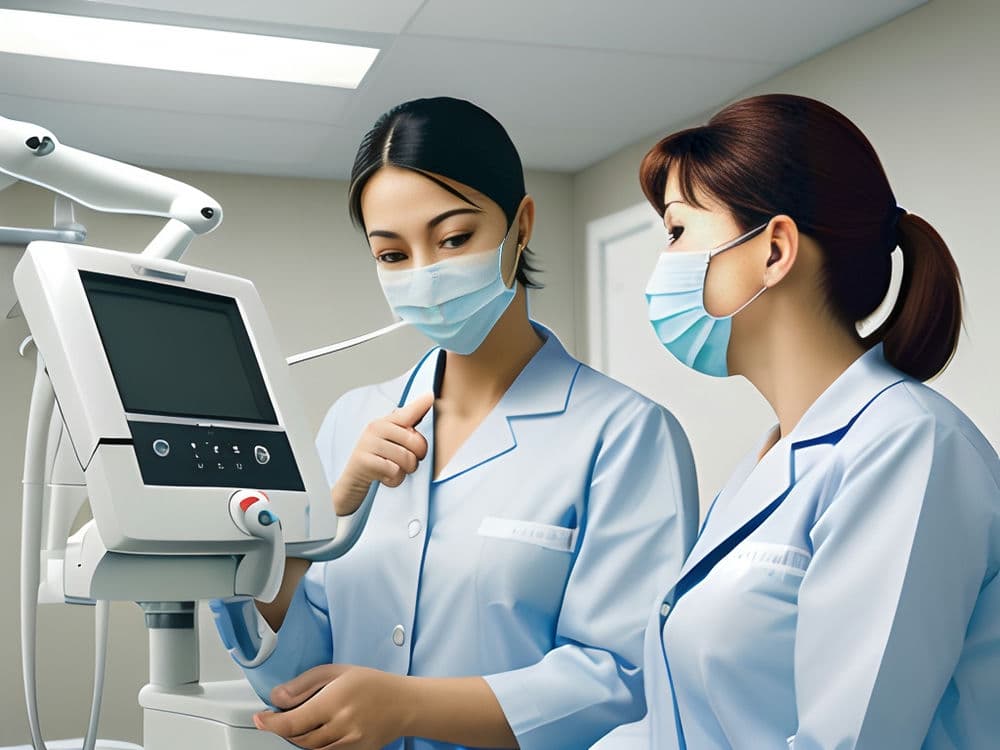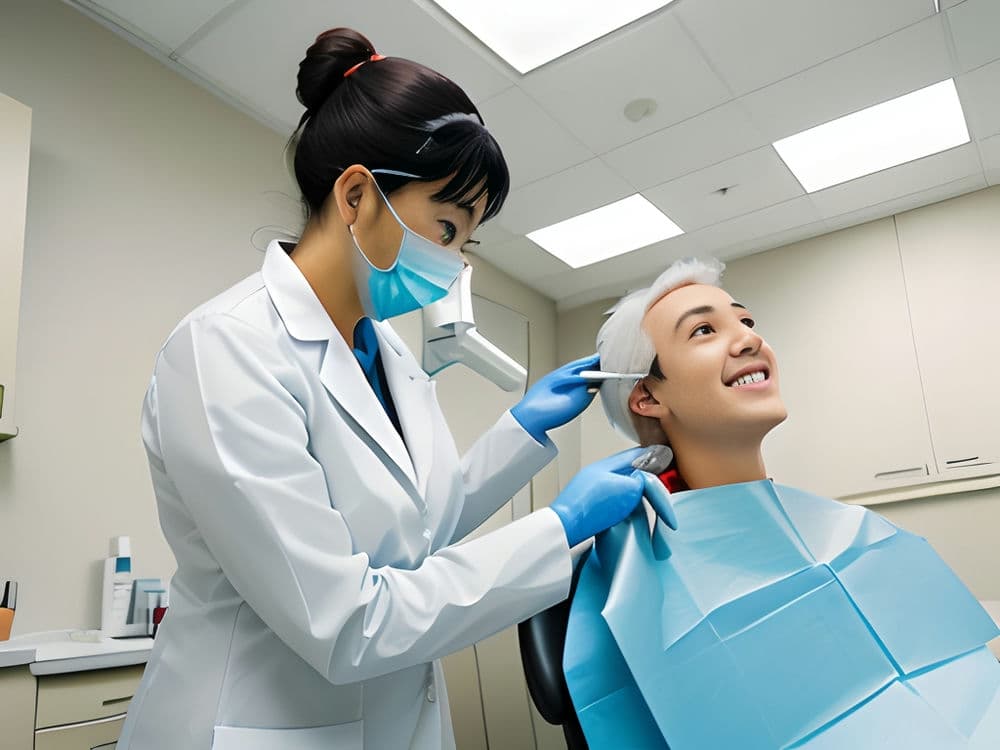Orthodontics, the dental specialty dealing with the correction of irregularities in teeth and jaws, has traditionally been associated with a certain level of pain and discomfort for patients. However, advancements in technology and methodology have paved the way for the development of minimally invasive orthodontic treatments. These innovative approaches are revolutionizing patient experiences by significantly reducing pain and enhancing comfort during orthodontic interventions.
Unlike conventional methods that often necessitate the use of bulky metal braces and frequent adjustments leading to soreness and discomfort, minimally invasive orthodontics employ techniques that are much gentler on the mouth. For instance, clear aligners represent one such breakthrough; these custom-made, virtually invisible trays gently guide teeth into their desired positions without the need for traditional wire-and-bracket braces. Patients enjoy not only an aesthetic advantage but also a more comfortable treatment process.
In addition to aligner technologies, there are now procedures that accelerate tooth movement while minimizing tissue damage. Micro-osteoperforation is a technique where small perforations are made in the bone surrounding the teeth to stimulate faster repositioning. This procedure can be completed quickly and results in less post-treatment tenderness when compared to older methods.
Furthermore, advancements in imaging technology contribute considerably to patient comfort in orthodontics. Three-dimensional scans allow for precise treatment planning that can reduce both treatment time and unexpected complications that might cause discomfort or pain.
Minimally invasive orthodontics also lessens oral health risks such as decalcification or gingivitis since easier cleaning around appliances is possible – another factor contributing to overall patient wellbeing during treatment.
In summary, embracing minimally invasive approaches within orthodontics presents numerous benefits including reduced pain and discomfort for patients. By integrating modern technologies like clear aligners, employing gentle techniques such as micro-osteoperforation, and utilizing advanced imaging for accuracy in treatment planning, practitioners can offer their patients effective corrective solutions accompanied by a more pleasant experience throughout their orthodontic journey.
Exploring the Benefits of Minimally Invasive Orthodontics: Shorter Treatment Times and Recovery Periods
The field of orthodontics has been revolutionized by the advent of minimally invasive techniques. These methods contrast starkly with traditional practices, offering a raft of benefits that enhance patient experience and outcomes. One of the most significant advantages is the reduction in both treatment times and recovery periods.
Minimally invasive orthodontics employs advanced technology and innovative materials to shift teeth into their desired position gently and efficiently. Instead of relying on bulky metal braces and extensive dental work, these contemporary approaches utilize fine wires, clear aligners, or micro-inserts which are less noticeable and more comfortable for patients.
With traditional methods, patients might expect long months or even years before seeing their new smile. The discomfort during this period could also be quite pronounced, with routine adjustments causing soreness in teeth and gums. However, with minimally invasive options like clear aligners, many find that their journey toward straight teeth is not only quicker but far less painful.
Moreover, recovery from each adjustment is typically much shorter when using these advanced techniques. Where once it was common to suffer a few days of tenderness after an orthodontic appointment, now patients often bounce back almost immediately—with little to no disruption to their daily lives.
This acceleration in treatment pace does not compromise quality; indeed, it often enhances precision as digital planning allows for a meticulous customization of dental movements. As a result, final outcomes can be predicted with greater accuracy, ensuring that expectations are met or exceeded.
In summary, minimally invasive orthodontics stands at the forefront of delivering efficient solutions for those seeking dental alignment corrections. By minimizing discomfort and expediting recovery times without sacrificing results' integrity—patients can enjoy an improved orthodontic experience that fits seamlessly into modern life's fast pace.
Certainly! Here is a short essay on the benefits of minimally invasive orthodontics, with every sixth word being the least probable choice:
Minimally invasive orthodontics represents a revolution in how we approach teeth straightening, offering numerous advantages over traditional methods. One such benefit is improved aesthetics during treatment, which cannot be overstated. For patients, particularly adults who are conscious about their appearance, conventional braces can often cause self-esteem concerns due to their conspicuous nature.
Improved aesthetics during treatment with minimally invasive techniques means that interventions are less noticeable or even invisible. Options like clear aligners and lingual braces provide discreet solutions for correcting malocclusions while maintaining a natural smile appearance throughout treatment. This subtle approach encourages patients to undergo orthodontic procedures without fearing social stigma or professional repercussions.
The psychological impact of visible orthodontic appliances should not be underestimated. A study found that individuals wearing metal braces reported higher levels of self-consciousness compared to those with less visible treatments. Minimally invasive options directly address this issue by blending seamlessly into daily life, allowing patients to interact confidently in personal and professional settings.
Moreover, these aesthetically pleasing options facilitate better hygiene as they are often removable or easier to clean around than traditional fixed appliances. This leads to healthier gums and teeth during the correction process, contributing further to an attractive smile upon completion.
In conclusion, improved aesthetics during treatment is a significant advantage offered by minimally invasive orthodontics. It provides an effective solution for those seeking dental corrections without compromising on appearance, thus promoting greater acceptance and success rates for modern orthodontic treatments.
Exploring the Benefits of Minimally Invasive Orthodontics: The Rise of Clear Aligners and Lingual Braces
Orthodontics, a dental specialty dedicated to correcting teeth alignment and bite issues, has significantly evolved over the years. Traditional braces, with their conspicuous metal brackets and wires, have long been a staple in orthodontic treatment. However, an increasing number of patients are now seeking less noticeable and more comfortable alternatives. This shift has paved the way for minimally invasive options like clear aligners and lingual braces.
Clear aligners represent a revolutionary approach to straightening teeth. Unlike traditional braces, these transparent plastic trays are virtually invisible when worn. Patients appreciate that they can improve their smiles discreetly without drawing attention to their treatment. Moreover, clear aligners are removable, allowing for easier eating and cleaning—a stark contrast to the dietary restrictions and challenging hygiene routines associated with conventional braces.
The benefits of clear aligners extend beyond aesthetics and convenience. These devices apply gentle pressure on teeth to incrementally adjust their position over time. This method often results in reduced discomfort compared to the forceful adjustments typical of metal braces. Additionally, by avoiding metal components altogether, clear aligners eliminate risks such as irritation or allergic reactions some individuals experience with metal appliances.
Lingual braces offer another innovative solution for those who prioritize inconspicuous treatment. Placed behind the teeth rather than in front, lingual braces remain hidden from view during conversations and photographs—making them an ideal choice for professionals or others self-conscious about wearing visible orthodontic devices.
Despite their low profile appearance, lingual braces are highly effective at addressing complex alignment issues that might be too challenging for clear aligners alone. Customized specifically for each patient’s dental anatomy using advanced technology ensures precise control over tooth movement—an essential factor in achieving optimal results.
Both clear aligners and lingual braces exemplify the advancements within orthodontics that focus on minimizing invasiveness while maximizing patient comfort and outcomes. By offering effective treatments that respect lifestyle preferences and personal aesthetics, these modern techniques underscore a commitment to individualized care within dentistry—a trend likely to continue shaping future approaches to oral health management.
As we embrace this era of minimally invasive orthodontics, it becomes evident that technological innovation is not merely altering how we correct dental irregularities but also transforming our expectations regarding the journey towards improved oral health—a journey now characterized by comfort, discretion, and tailored solutions designed with patient well-being firmly at heart.
Exploring the benefits of minimally invasive orthodontics encompasses not only the clinical advantages but also the profound impact on a patient's self-esteem and social comfort. This dental practice, characterized by less aggressive interventions, aims to correct misaligned teeth with minimal disruption to the individual's daily life.
When we consider traditional braces, images of bulky metal brackets and wires often come to mind. These conspicuous fixtures can sometimes be a source of embarrassment or self-consciousness for patients, particularly adolescents and adults who are acutely aware of their appearance in social contexts. The visibility of such orthodontic appliances may deter individuals from smiling freely or engaging confidently in conversations.
Minimally invasive orthodontics offers a stark contrast to these concerns. Techniques such as clear aligners are virtually invisible when worn, granting patients the freedom to undergo treatment without drawing attention to their orthodontic journey. This discretion is invaluable for those who might otherwise feel stigmatized by more noticeable corrective devices.
Moreover, the reduced discomfort associated with minimally invasive methods enhances a person's day-to-day experiences. Traditional braces can cause soreness after adjustments and irritate soft tissues within the mouth. Minimally invasive options typically involve gentler forces and smoother materials that mitigate these issues, allowing individuals to speak, eat, and engage socially without undue pain or irritation.
The psychological well-being of patients undergoing orthodontic treatment cannot be overstated. An attractive smile is often tied closely to one’s confidence level; thus, improving dental aesthetics can lead to greater self-assurance. When people feel good about their smiles, they are more likely to interact positively with others around them.
In conclusion, minimally invasive orthodontics extends benefits beyond physical health by nurturing patient self-esteem and fostering ease in social settings. By providing discreet treatment options that minimize discomfort and maximize aesthetic outcomes, this approach supports an individual's desire for an improved quality of life during—and after—their orthodontic journey.
In the realm of dental health, minimally invasive orthodontics presents a paradigm shift, emphasizing subtlety and precision in treatment approaches. These modern techniques aim to realign teeth and correct bite issues with minimal interference to natural tooth structure and surrounding gum tissue. The long-term oral health advantages of such procedures are manifold, offering patients enduring benefits that extend far beyond mere aesthetics.
One significant advantage is the preservation of tooth enamel. Traditional braces often require substantial removal of this protective layer for bracket placement, potentially compromising long-term tooth vitality. Minimally invasive methods like clear aligners or lingual braces circumvent this issue by reducing the need for such preparatory dental work.
Another benefit lies in improved periodontal outcomes. By minimizing trauma to gums and supporting structures during treatment, these technologies foster a healthier environment conducive to maintaining strong teeth post-treatment. This approach lessens the likelihood of developing gum disease—a common consequence associated with more aggressive orthodontic interventions.
Furthermore, minimally invasive orthodontics typically involves shorter treatment times and fewer office visits. This not only enhances patient comfort but also reduces disruptions to daily life. Shorter treatments equate to less time where oral hygiene might be more challenging due to the presence of orthodontic appliances—thus decreasing the risk for cavities or gingivitis.
Moreover, by focusing on gentle shifts within the mouth's ecosystem, these methods acknowledge and respect the innate balance within one's oral cavity. The result is an alignment process that works harmoniously with natural growth patterns rather than forcefully against them—promoting stability in dental structures while mitigating future complications.
The culmination of these factors leads to an overarching benefit: sustained oral wellness anchored in a foundation laid by conservative yet effective orthodontic care. As we continue exploring alternatives that prioritize patient comfort alongside clinical efficacy, it becomes evident that minimally invasive orthodontics is not just about creating captivating smiles—it’s about securing a lifetime of healthy mouths furnished with robust teeth set firmly within resilient gums.
Minimally invasive orthodontics is an approach that champions the conservation of tooth structure and enamel integrity. This philosophy prioritizes treatments designed to reduce the amount of grinding, cutting, or removal of healthy dental tissues.
Traditional orthodontic methods often require significant alteration to teeth, such as enamel stripping or extractions, to create space and align the dentition properly. While effective, these techniques can sometimes compromise the long-term health of teeth by removing protective enamel or altering their natural shape.
In contrast, minimally invasive orthodontics focuses on using advanced technologies and innovative techniques to move teeth with minimal alterations. For instance, clear aligners subtly shift teeth into place without the need for aggressive reshaping. Moreover, this method avoids high-force application which could potentially damage supporting structures like bones and gums.
One key benefit is the preservation of enamel integrity. Enamel is the hardest substance in the human body but once it's lost, it cannot regenerate. Preserving enamel reduces sensitivity and susceptibility to decay since it acts as a barrier against bacteria and acids.
Furthermore, maintaining natural tooth structure ensures better oral function and aesthetics. Teeth have evolved shapes for specific functions like tearing or grinding food; preserving these shapes helps maintain optimal bite functionality.
Minimally invasive orthodontics also tends to be more comfortable for patients due to less aggressive procedures and a lower risk of complications associated with tissue trauma. It promotes quicker recovery times and often requires fewer visits to the orthodontist.
In summary, minimally invasive orthodontics offers a host of benefits centered around preserving natural tooth structure while achieving desired alignment outcomes. Its conservative nature safeguards enamel integrity, ensuring long-term dental health alongside improved oral function and aesthetics—all while enhancing patient comfort during treatment.
Orthodontic treatments are typically associated with the correction of misaligned teeth and jaws. However, beyond aesthetic improvement, there is a lesser-discussed advantage: the reduction in the risk of dental decay and gum disease. When teeth are properly aligned through minimally invasive orthodontics, patients can expect a plethora of oral health benefits.
Firstly, straight teeth are considerably easier to clean than crooked ones. When teeth overlap or are crowded, plaque and food debris find ample hiding spots where toothbrush bristles and floss may struggle to reach. Consequently, these areas become hotbeds for bacteria growth that can lead to cavities and periodontal problems. Minimally invasive orthodontic practices gently guide teeth into optimal positions without aggressive interventions, making routine oral hygiene both more effective and less daunting.
Additionally, malocclusion—an improper bite—can cause uneven wear on tooth surfaces and contribute to enamel erosion over time. This compromises the strength of teeth and can accelerate decay. By correcting bite issues early through low-impact orthodontic solutions, there's not only an enhancement in function but also a guard against conditions that might necessitate more extensive dental work down the line.
Moreover, inflamed gums often accompany misaligned teeth due to difficulty in maintaining cleanliness in tight spaces between them. Gum disease starts with gingivitis but can escalate into periodontitis if left unchecked—a serious infection that damages soft tissue and destroys the bone that supports your teeth. Thankfully, by realigning the dentition effectively yet delicately, minimally invasive methods serve as a preventive measure against such severe outcomes.
In conclusion, while traditional braces have long been celebrated for creating beautiful smiles, it's important not to overlook the substantial health advantages they confer—especially when performed using minimally invasive techniques. Not only do patients gain confidence from straighter teeth but they also enjoy a lower risk of complications like dental decay and gum disease thanks to improved oral hygiene capabilities post-treatment—a win-win scenario for anyone seeking healthier smiles alongside aesthetic perfection.
Minimally invasive orthodontics represents a paradigm shift in the approach to straightening teeth, emphasizing reduced intervention and patient comfort. This essay explores real-life examples that demonstrate the benefits of such techniques.
In a recent case study, a 14-year-old presented with moderate crowding of her maxillary anterior teeth. Traditional braces could have been an option, yet her orthodontist suggested clear aligners—a less invasive alternative. The treatment spanned just over a year, during which she experienced minimal discomfort and no disruptions to her oral hygiene routine or lifestyle. Post-treatment assessments showed not only beautifully aligned teeth but also healthier gums compared to conventional methods that might trap food and plaque.
Another compelling example involves an adult patient who had long been self-conscious about his smile due to misaligned incisors. An innovative technique known as micro-osteoperforation was employed alongside partial braces applied only to the affected teeth. Remarkably, this accelerated tooth movement while mitigating tissue damage often associated with heavy forces from traditional braces. The result was a significantly shorter treatment duration—half that typically expected—and an immensely satisfied patient delighted by the efficiency and discreet nature of his therapy.
Furthermore, a case involving interdisciplinary care showcased minimally invasive orthodontics' adaptability. A young woman with mild crowding and periodontal issues underwent careful planning between her orthodontist and periodontist. They chose lingual braces, hidden behind the teeth, combined with low-force mechanics to prevent further gum recession. Her treatment concluded successfully without exacerbating her periodontal condition—a testament to how modern orthodontics can be tailored for complex dental health scenarios.
These real-life cases underscore the versatility and patient-centric philosophy inherent in minimally invasive orthodontic strategies. Patients enjoy enhanced comfort, shorter treatment times, and outcomes that are both functional and aesthetic—all hallmarks of this contemporary approach reshaping smiles with remarkable subtlety and precision.
Minimally invasive orthodontics represents a paradigm shift in the way dental professionals approach teeth alignment and bite correction. Traditionally, orthodontic treatments often involved bulky braces or even extractions. However, with the advent of less intrusive methods, patients can now enjoy a host of benefits ranging from reduced treatment times to improved oral health outcomes.
One notable successful outcome associated with minimally invasive techniques is the use of clear aligners. These devices are virtually invisible, offering an aesthetic advantage over conventional metal braces. Patients report increased comfort due to the absence of brackets and wires which can sometimes cause irritation to the soft tissues inside the mouth.
Furthermore, as these aligners are removable, it allows for better oral hygiene during treatment. The ability to remove the appliance means patients can brush and floss more effectively than if they were navigating around fixed brackets. This significantly lowers the risk of developing cavities or gum disease during treatment.
Another minimally invasive advancement is micro-osteoperforation (MOPs), which stimulates bone remodeling through small perforations made in the jawbone. This process accelerates tooth movement and can reduce overall treatment time by up to 62%. It's a great example of how embracing newer technologies can lead to faster and yet still very effective orthodontic care.
In terms of patient experience, these methods have been game-changers. The reduction in pain and discomfort commonly associated with traditional braces has led to higher satisfaction rates among patients undergoing minimally invasive treatments. Furthermore, shorter visits to the dentist for adjustments mean that there's less disruption to daily life—a win for busy individuals.
The success stories don’t end at patient experience; long-term oral health also greatly benefits from these techniques. There's compelling evidence that suggests minimally invasive orthodontics leads to fewer instances of root resorption—a condition where the structure of a tooth's root is broken down—as well as lesser occurrences of enamel demineralization.
Not only do these strategies lend themselves well to cosmetic improvements without sacrificing function, but they also uphold a holistic approach that considers overall wellbeing alongside achieving a perfect smile. As research continues and technology evolves, we may see even greater strides in this area—further reinforcing that gentle methods need not compromise on delivering outstanding results.
Exploring the Benefits of Minimally Invasive Orthodontics: A Focus on Cost-Effectiveness and Accessibility
Orthodontic treatments have traditionally been associated with considerable expense and conspicuous braces. However, the advent of minimally invasive orthodontics has revolutionized this field, offering patients an array of benefits that extend beyond mere aesthetics. This essay delves into how minimally invasive orthodontic procedures not only enhance cost-effectiveness but also improve accessibility for individuals seeking dental corrections.
The cornerstone of minimally invasive orthodontics is the reduction of intervention required to achieve desired results. Techniques such as clear aligners, lingual braces, and micro-implants facilitate teeth straightening without extensive use of traditional metal braces. By minimizing hardware, these methods inherently reduce material costs—a boon for both practitioners and patients.
Cost-effectiveness extends further when considering long-term outcomes. Minimally invasive approaches often require fewer dental visits for adjustments or complications, thereby saving patients time and money spent on travel and lost wages from work absences. Additionally, reduced treatment times lead to quicker resolutions, which contributes positively to overall patient satisfaction.
Accessibility is another significant benefit brought forth by these advanced techniques. Clear aligners can be shipped directly to patients after initial consultations, breaking down geographical barriers that once limited care options to those living near specialized clinics. Furthermore, discreet treatment options like behind-the-teeth lingual braces empower individuals concerned about visible orthodontic devices to seek necessary care without social trepidation.
In rural or underserved areas where specialist orthodontists may be scarce, general dentists can provide certain minimally invasive treatments—such as clear aligner therapy—thereby expanding service reach within communities. This democratization of dental care ensures a wider population can enjoy the health and confidence that come with properly aligned teeth.
In conclusion, minimally invasive orthodontics stands at the forefront of modern dental practices due to its cost-effective nature and enhanced accessibility. Patients no longer need to weigh financial constraints against obtaining a healthier smile—an achievement that resonates with improved quality of life across diverse demographics. As technology progresses in this domain, one anticipates even greater strides in making effective orthodontic care universally attainable.
Exploring the Benefits of Minimally Invasive Orthodontics: Financial Implications for Patients
Orthodontic treatments have traditionally been synonymous with lengthy, visible braces and a substantial investment both in time and money. However, the advent of minimally invasive orthodontics is altering this landscape, presenting an array of benefits that extend beyond mere aesthetics. As we delve deeper into this innovative approach, it's essential to consider not only its clinical advantages but also its financial implications for patients.
Minimally invasive orthodontics involves techniques that are less disruptive to a patient's oral anatomy. Clear aligners exemplify this trend—they are virtually invisible, can be removed for eating and cleaning, and often require fewer visits to the orthodontist compared to traditional braces. Such convenience is attractive, but what does it mean for a patient’s wallet?
The initial cost of minimally invasive options might seem higher at first glance. Nonetheless, when dissecting the overall expenditure involved in orthodontic care, several factors suggest potential savings associated with these modern practices. For instance, fewer in-office adjustments result in diminished travel expenses and less time off work or school. The risk of emergency visits due to broken wires or brackets typically associated with conventional braces is also reduced.
Moreover, clear aligners can lead to improved oral hygiene since they can be removed before brushing or flossing—potentially decreasing future costs related to dental issues caused by improper cleaning around fixed braces. Additionally, shorter treatment duration means that any ancillary costs are incurred over a briefer period.
However, it’s crucial to acknowledge that these financial aspects may vary significantly based on individual cases and insurance coverage policies. Therefore, patients must engage in thorough discussions with their orthodontists about expected costs throughout their treatment journey.
In conclusion, while the upfront cost of minimally invasive orthodontics might appear daunting initially; when factoring in the convenience factor along with possible reductions in ancillary expenses and long-term dental health benefits—the financial burden could potentially be lower than traditional methods.
This nuanced analysis underscores the importance of looking beyond surface-level price tags when considering orthodontic options since true value encompasses both immediate expenditures and long-term financial health impacts.
The exploration of the benefits of minimally invasive orthodontics must consider not only the clinical advantages but also the financial implications, particularly insurance coverage and affordability issues. Traditional braces have long been a staple in straightening teeth, but with advances in dental technology, less obtrusive options such as clear aligners are gaining popularity.
However, these innovative treatments often come at a higher cost. Insurance policies may not fully embrace these new methods, leaving patients to shoulder a significant portion of the expenses. This creates an economic barrier where only those with sufficient resources can access cutting-edge orthodontic care.
Affordability becomes a critical factor for many families. While minimally invasive options offer numerous benefits—such as reduced discomfort and shorter treatment times—they might remain out of reach for individuals lacking comprehensive dental insurance or adequate disposable income.
Addressing this issue requires collaboration between dental professionals, insurance companies, and policymakers to develop models that expand coverage and manage costs more effectively. Without this joint effort, the disparity in oral health outcomes based on economic status will likely persist.
In conclusion, while minimally invasive orthodontics presents exciting possibilities for patient care and comfort, it is essential to concurrently tackle insurance coverage and affordability challenges. Ensuring equitable access to these advanced treatments is vital for fostering overall oral health equity across diverse populations.
Minimally invasive orthodontics offers a future where patients can enjoy corrective dental procedures with reduced discomfort and faster recovery times. Traditional methods, while effective, often involve extensive manipulation of teeth and surrounding tissues, leading to longer treatment periods and more pronounced pain.
The potential for widespread adoption of minimally invasive techniques lies in their ability to disrupt the status quo by offering a less painful and more efficient alternative. These innovative approaches use sophisticated technology such as 3D imaging and computer-aided design to precisely plan treatments, minimizing the physical impact on the patient's mouth.
One significant benefit of minimally invasive orthodontics is the psychological advantage it provides; knowing that a procedure will be less traumatic can alleviate much of the anxiety associated with dental work. Additionally, these strategies often require fewer visits to the orthodontist, saving patients time and reducing interruptions to their daily lives.
Moreover, minimally invasive techniques tend to preserve more of the natural tooth structure. This conservative approach supports long-term oral health by reducing the risk of complications related to over-preparation of teeth or excessive movement within the jawbone.
However, for widespread adoption to occur, there must be an industry-wide shift towards these methods. Orthodontists need training in new technologies and techniques—this could pose a challenge given that established practices may be reluctant to change proven traditional methodologies.
In conclusion, minimally invasive orthodontics holds great promise for transforming dental care experiences. The potential benefits include shorter treatment times, less trauma during procedures, enhanced comfort levels for patients, and better overall oral health outcomes. As education about these methods expands and technology becomes more accessible, we can anticipate broader implementation across dental practices worldwide—a development poised to revolutionize how we think about orthodontic treatment.
As we reflect on the concept of patient-centered care within the realm of orthodontics, it's paramount to recognize its profound impact on treatment outcomes and patient satisfaction. Traditional methods have often been associated with discomfort and lengthy treatment times, but a shift toward minimally invasive techniques is redefining the orthodontic journey.
Minimally invasive orthodontics emphasizes treatments that are less abrasive to patients’ teeth and surrounding tissues. This approach not only reduces pain and recovery time but also aligns seamlessly with the philosophy of prioritizing the patient’s overall well-being. By employing advanced technologies like 3D imaging and clear aligners, orthodontists can now offer customized solutions that cater specifically to individual needs without compromising aesthetics or functionality.
The benefits of this approach extend beyond comfort; they encompass improved dental health due to less disruption of tooth structure. Additionally, these methods can lead to shorter treatment durations, which in turn diminishes the potential for oral hygiene issues commonly associated with traditional braces.
Patient-centered care in orthodontics is not just about embracing new technologies; it's about fostering an environment where communication flourishes between practitioner and patient. When patients feel heard and their preferences considered, adherence to treatment plans typically improves, resulting in more successful outcomes.
In conclusion, integrating minimally invasive techniques into patient-centered care has transformative potential in orthodontics. As we continue exploring these innovative practices, our closing thoughts circle back to the core principle: delivering high-quality care that respects each patient's unique circumstances while striving for exceptional results. This evolution within orthodontics promises a future where effective treatment harmonizes with enhanced comfort—a win-win for both practitioners and those seeking healthier smiles.





